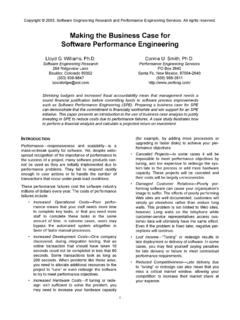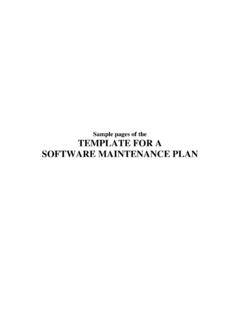Transcription of IACE-Indian Academy Of Competitive Exams IBPS SO ...
1 IACE-Indian Academy Of Competitive Exams ibps SO professional knowledge Exclusive for IACE Students Ph: 9700077455/422 Page 1 software engineering software engineering software engineering is an engineering approach for software development. We can alternatively view it as a systematic collection of past experience. The experience is arranged in the form of methodologies and guidelines. A small program can be written without using software engineering principles. But if one wants to develop a large software product, then software engineering principles are indispensable to achieve a good quality software cost effectively. These definitions can be elaborated with the help of a building construction analogy.
2 PROJECT PLANNING Once a project is found to be feasible, software project managers undertake project planning . Project planning is undertaken and completed even before any development activity starts. Project planning consists of the following essential activities: Estimating the following attributes of the project: Project size: What will be problem complexity in terms of the accuracy of these estimations. Scheduling man power and other resources Staff organization and staffing plans Risk identification, analysis, and abatement planning Miscellaneous plans such as quality assurance plan, configuration management plan, etc PRECEDENCE ORDERING AMONG PROJECT PLANING ACTIVITIES The project planning activity is undertaken before the development starts to plan the activities to be undertaken during development.
3 The project monitoring and control activities are undertaken once the development activities start with the aim of ensuring that the development proceeds as per plan and changing the plan whenever required to cope up with the situation. It is also the most fundamental parameter based on which all other planning activities are carried out. Other estimations such as estimation of effort, cost, resourced and project duration are also very important components of project planning Effect cost Estimation Estimation Size Estimation Duration Project Scheduling Estimation Stating SLIDING WINDOW PLANNING project planning requires utmost care and attention since commitment to unrealistic time and resource estimates results in schedule slippage.
4 Schedule delays can cause customer dissatisfaction and adversely affect team morale. It can even cause project failure. However, project planning is a very challenging activity. Especially for large projects. It is very much difficult to make accurate plans. A part of this difficulty is due to the fact that the proper parameters, scope of the projects, project staff, etc. may change during the span of the project. In order to overcome this problem, sometimes project managers undertake project planning in stages. Planning from making big commitments too early. This technique of staggered planning is known as sliding window planning. In the sliding window technique, starting with an initial plan, the project is planned more accurately in successive development stages. PROJECT MANAGEMENT CONCEPTS Project management remains a very necessary activity when computer based systems and products are built.
5 Project management involves the planning. Monitoring and control of the people, process, and event that occur as software evolves from a preliminary concept to an operational implementation. Everyone manages to some extent, but the scope of IACE-Indian Academy Of Competitive Exams ibps SO professional knowledge Exclusive for IACE Students Ph: 9700077455/422 Page 2 management activities varies with the person doing it. A software engineer manages her day-to-day activities, planning, monitoring, and controlling technical tasks. Project managers plan, monitor, and control the work of a team of software engineers. Senior managers coordinate the interface between the business and the software professionals.
6 Building computer software is a complex undertaking. Particularly if it involves many people working over a relatively long time. That s why software projects need to be managed. Understand the four p s --- people, product, process, and project. people must be organized to perform software work effectively. Communication with the customer must occur so that product scope and requirements are understood. A process must be selected that is appropriate for the people and the product. The project must be planned by estimating effort and calendar time to accomplish work tasks; defining work products, establishing quality checkpoints, and establishing mechanisms to monitor and control work defined by the plan. PROJECT PLANNING OBJECTIVES The objective of software project planning is to provide a framework that enables the manager to make reasonable estimates of resources, cost, and schedule.
7 These estimates are made within a limited time frame at the beginning of a software project and should be updated regularly as the project progresses. In addition, Estimates should attempt to define best case and worst case scenarios so that project outcomes can be process of information discovery that leads to reasonable estimates. SYSTEM engineering System engineering is the activity of specifying designing implementing, validating deploying and maintaining system. System engineer are not just concerned with software but also with hardware and the system s interactions with users and its environment. They must think about the services that the system provides the constraints under which the system must be built and operated and the ways in which the system is used to fulfill its purpose.
8 PROGRAM TESTING Testing a program consists of providing the program with a set of test inputs (or test cases) and observing if the program behaves as expected, If the program falls to behave as expected, then the conditions under which failure occurs are noted for later debugging and correction. Some commonly used terms associated with testing are: Failure: This is a manifestation of an error (or defect or bug). But, the mere presence of an error may not necessarily lead to a failure. Test case: This is the triplet [I,S,S], where I is the data input to the system. S is the state of the system at which the data is input, and O is the expected output of the system. Test suite: This is the set of all test cases with which a given software product is to be tested. Design of test cases Exhaustive testing of almost any non-trivial system is impractical due to the fact that the domain of input data values to most practical software systems is either extremely large or infinite.
9 Therefore, we must design an optical test suite that is of reasonable size and can uncover as many errors existing in the system as possible. Testing a system using a large collection of test cases that are selected at random does not guarantee that all (or even most) of the error in th system will be uncovered. BLACK BOX TESTING In the black box testing, test cases are designed from an examination of the input/output values only and no knowledge of design or code is required. The following are the two main approaches to designing black box test cases. Equivalence class portioning Boundary value analysis Equivalence Class Partitioning The domain of input values to a program is partitioned into a set of equivalence classes. This partitioning is don such that the behavior of the program is similar for every input data belonging to the same equivalence class.
10 The main idea behind defining the equivalence classes is that testing the code with any one value belonging to an equivalence class is as good as testing the software with any other value belonging to that equivalence class. Equivalence classes for a software can be designed by examining the input data and output data. The following are some general guidelines for designing the equivalence classes: 1. If the input data values to a system can be specified by a range of values. Then one valid and two invalid equivalence classes should be defined. 2. If the input data assumes values from a set of discrete members of some domain, then one equivalence class for valid input values and another equivalence class for invalid input values should be defined.





